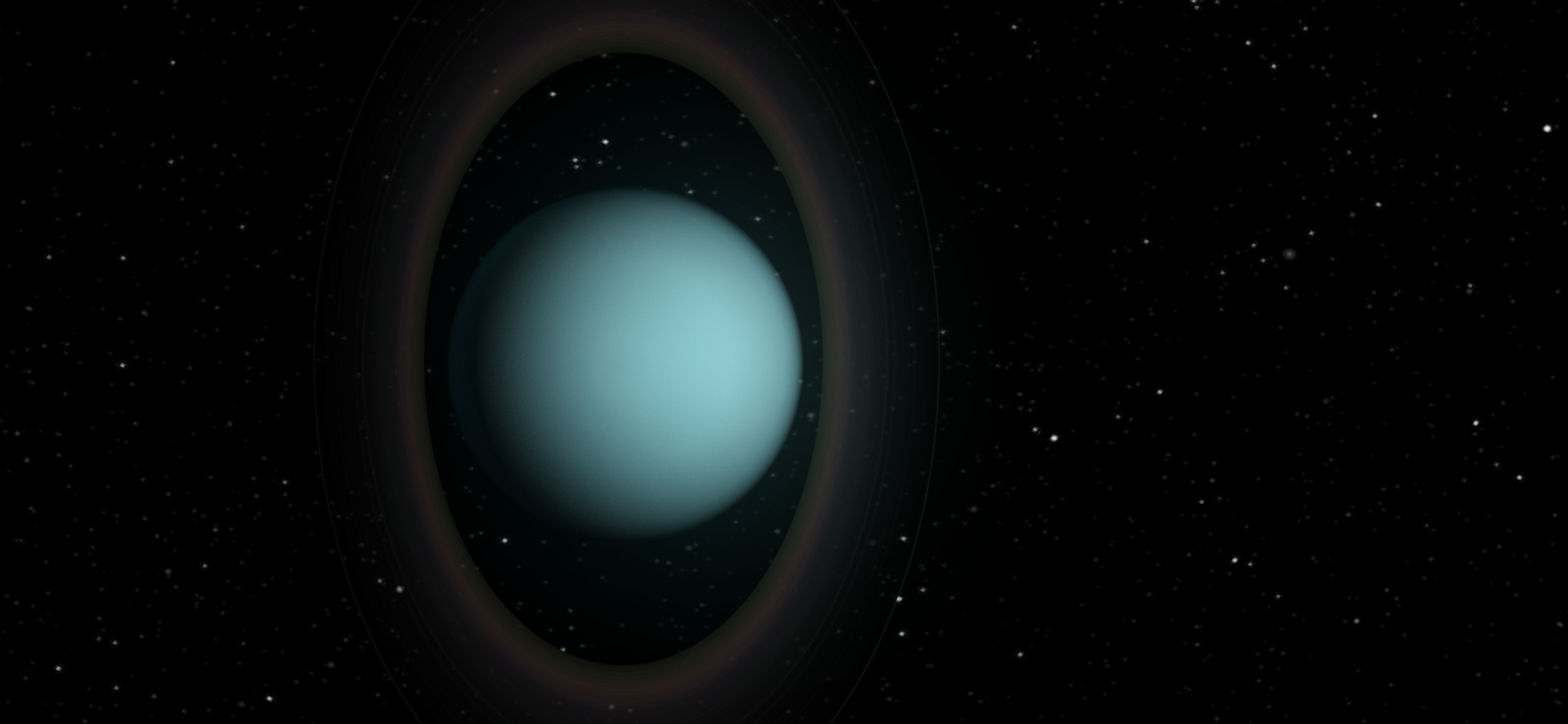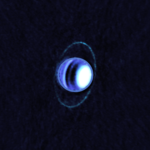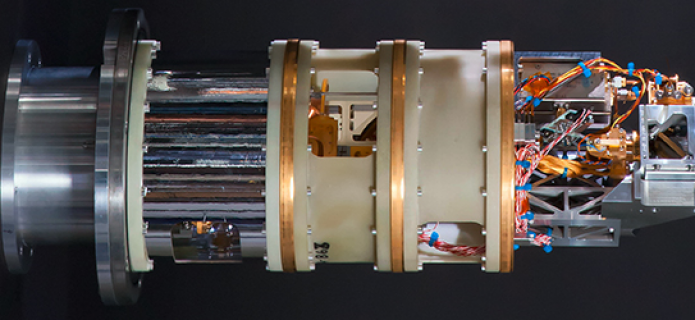Planetary Rings of Uranus Glow in Cold Light
Using the Atacama Large Millimeter/submillimeter Array (ALMA) and the Very Large Telescope (VLT), astronomers have imaged the cold, rock-strewn rings encircling the planet Uranus. Rather than observing the reflected sunlight from these rings, ALMA and the VLT imaged the millimeter and mid-infrared glow naturally emitted by the frigidly cold particles of the rings themselves. Only discovered in 1977, Uranus rings are invisible to most but the largest telescopes. However, they are surprisingly bright in the thermal images from ALMA and VLT.
The thermal glow gives astronomers another window onto the rings, which only have been seen because they reflect a little light from the Sun. The new images taken by ALMA and the VLT allowed the team for the first time to measure the temperature of the rings: a cool 77º Kelvin, or 77º degrees above absolute zero; equivalent to -196.15º Celsius.
The observations also confirm that Epsilon, Uranus's brightest and densest ring, differs from the other known rings within our solar system, in particular, the spectacularly beautiful rings of Saturn, that “are broad, bright and have a range of particle sizes, from micron-sized dust in the innermost D ring to tens of meters in size in the main rings," said Imke de Pater, a UC Berkeley professor of astronomy. "The small end is missing in the main rings of Uranus; the brightest ring, epsilon, is composed of golf ball-sized and larger rocks.”
By comparison, Jupiter's rings contain mostly small, micron-sized particles (a micron is a thousandth of a millimeter). Neptune's rings are also mostly dust, and even Uranus has broadsheets of dust between its narrow main rings.
“We already know that the Epsilon ring is a bit weird because we don't see the smaller stuff,” said Edward Molter, a graduate student from the same university. “Something has been sweeping the smaller stuff out, or it's all glomming together. We just don't know. This is a step to further understanding their composition and whether all of the rings came from the same source material or are different for each one.”
Rings could be former asteroids captured by the planet's gravity, remnants of moons that crashed into one another and shattered, the remains of moons torn apart when they got too close to Uranus, or debris remaining from the formation 4.5 billion years ago.
The new data was published this week in The Astronomical Journal. De Pater and Molter led the ALMA observations, while Michael Roman and Leigh Fletcher from the University of Leicester, U.K., led the VLT observations.
"The rings of Uranus are compositionally different from Saturn's main ring, in the sense that in optical and infrared, the albedo, thus the reflectance capacity, is much lower: they are really dark, like charcoal," Molter said. "They are also extremely narrow compared to the rings of Saturn. The widest of them, Epsilon, varies from 20 to 100 kilometers wide, whereas Saturn's are hundreds or tens of thousands of kilometers wide."
The lack of dust-sized particles in Uranus's main rings was first noted when Voyager 2 flew by the planet in 1986, however, the spacecraft was unable to measure the temperature of the rings. To date, astronomers have counted a total of 13 rings around the planet, with some bands of dust between the rings.
"It's cool that we can even do this with the instruments we have," Molter said. "I was just trying to image the planet as best I could, and I saw the rings. It was amazing."
Both the VLT and ALMA observations were designed to explore the temperature structure of Uranus' atmosphere, with VLT probing shorter wavelengths than ALMA.
"We were astonished to see the rings jump out clearly when we reduced the data for the first time," Fletcher said.
This presents an exciting opportunity for the upcoming James Webb Space Telescope, which will be able to provide vastly improved details on the Uranian rings once launched in the coming decade.
Additional Information
This research is accepted for publication as "Thermal emission from the Uranian ring system," by E.M. Molter, et al., in the Astrophysical Journal. (Preprint: https://arxiv.org/abs/1905.12566).
The research team was composed by Edward M. Molter [1], Imke de Pater [1], Michael T. Roman [2], and Leigh N. Fletcher [2].
[1] Astronomy Department, University of California, Berkeley; Berkeley CA, 94720, USA.
[2] Department of Physics & Astronomy, University of Leicester, University Road, Leicester, LE1 7RH, UK.
The Atacama Large Millimeter/submillimeter Array (ALMA), an international astronomy facility, is a partnership of the European Organisation for Astronomical Research in the Southern Hemisphere (ESO), the U.S. National Science Foundation (NSF) and the National Institutes of Natural Sciences (NINS) of Japan in cooperation with the Republic of Chile. ALMA is funded by ESO on behalf of its Member States, by NSF in cooperation with the National Research Council of Canada (NRC) and the Ministry of Science and Technology (MOST) and by NINS in cooperation with the Academia Sinica (AS) in Taiwan and the Korea Astronomy and Space Science Institute (KASI).
ALMA construction and operations are led by ESO on behalf of its Member States; by the National Radio Astronomy Observatory (NRAO), managed by Associated Universities, Inc. (AUI), on behalf of North America; and by the National Astronomical Observatory of Japan (NAOJ) on behalf of East Asia. The Joint ALMA Observatory (JAO) provides the unified leadership and management of the construction, commissioning, and operation of ALMA.
Images
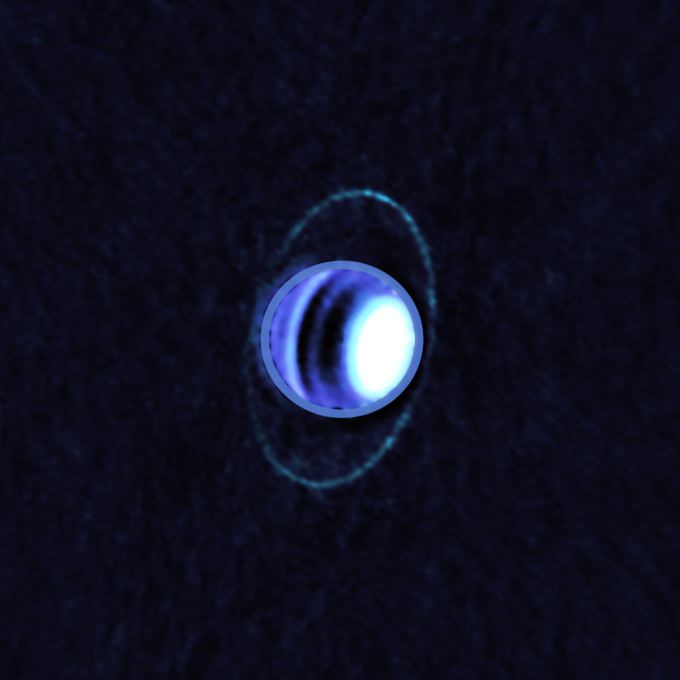
Composite image of Uranus’s atmosphere and rings at radio wavelengths, taken with the Atacama Large Millimeter/submillimeter Array (ALMA) in December 2017. The image shows thermal emission, or heat, from the rings of Uranus for the first time, enabling scientists to determine their temperature is a frigid 77 K (-320 F). Dark bands in Uranus’s atmosphere at these wavelengths show the presence of radiolight-absorbing molecules, in particular hydrogen sulfide (H2S) gas, whereas bright regions like the north polar spot contain very few of these molecules. Credit: ALMA (ESO/NAOJ/NRAO); E. Molter and I. de Pater.
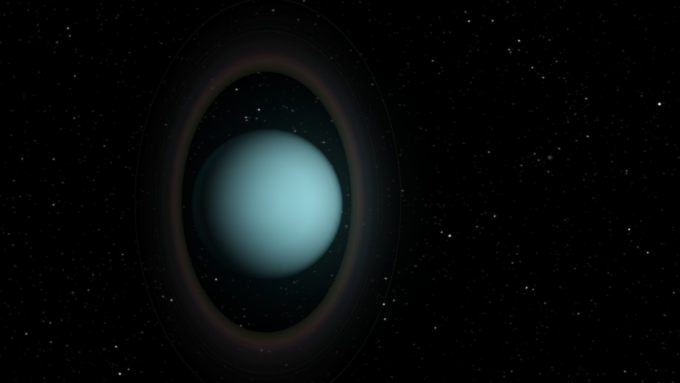
Artist impression of the planet Uranus and its dark ring system. Rather than observing the reflected sunlight from these rings, astronomers have imaged the millimeter and mid-infrared “glow” naturally emitted by the frigidly cold particles of the rings themselves. Credit: NRAO/AUI/NSF; S. Dagnello
Contacts
-
Nicolás Lira
Education and Public Outreach OfficerJoint ALMA Observatory, Santiago - ChilePhone: +56 2 2467 6519Cel: +56 9 9445 7726Email: [email protected] -
Charles E. Blue
Public Information OfficerNational Radio Astronomy Observatory Charlottesville, Virginia - USAPhone: +1 434 296 0314Cel: +1 202 236 6324Email: [email protected]
